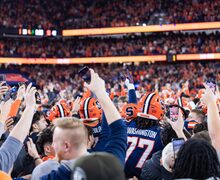Breaking down Syracuse’s new offense ahead of its spring game
Meghan Hendricks | Photo Editor
Damien Alford said Syracuse's new plays are easier to understand and help the offense move faster.
There’s still one Orange to root for — The Daily Orange! Donate today and help us win College Media Madness.
At the first practice after spring break, Garrett Shrader faked a handoff and let it fly. Starting from midfield, Anthony Queeley ran straight downfield as Garrett Williams attempted to cover him before cutting toward the middle of the field at the 30-yard line. After turning Williams around, Queeley stuck his right arm out, calling for the ball. Williams closed the gap near the goal line, and Shrader’s pass went just over Queeley’s outstretched hands.
Even with the incompletion, the play serves as a small example for the changes Syracuse has made — and is still making — to its offense this offseason, with the growing pains included. After offensive coordinator Sterlin Gilbert was fired, head coach Dino Babers turned to Robert Anae, then-UVA’s offensive coordinator, to improve an offense that finished in the bottom third of the Atlantic Coast Conference in each of Gilbert’s two seasons.
So since Shrader, Queeley and the rest of the Orange’s offense took the field in early March, the focus has been on learning a new, air-raid style offense, one that hopes to add a more lethal passing attack to a unit that already possesses one of the top ground games in the country behind All-American running back Sean Tucker.
Anae and new quarterbacks coach Jason Beck, also from Virginia, have been working alongside Babers on the install, the early versions of which will be displayed on Friday night during Syracuse’s annual intrasquad spring game. Players have said the team has emphasized moving faster and throwing the ball more, potentially moving Syracuse’s offense closer to the one that averaged almost 40 points per game in 2018.
“We’re doing a lot of good things,” Shrader said. “We love the scheme. We just got to buy in and make sure we’re on the same page.”
Shrader calls the new offense a lot more “wide-open” than the one SU had last year. There are more opportunities to take downfield shots, and more balance between the run and pass games, he said.
Syracuse’s offense was heavily reliant on Tucker and Shrader’s legs last season, and incorporated various designed quarterback runs. Shrader threw for fewer than 100 yards in three straight games late in the season, but said he didn’t feel like he threw the ball poorly last year. Instead, it was more about his receivers not finding open space.

Garrett Shrader and the rest of Syracuse’s quarterbacks have been adjusting to a newly-implemented offense over recent weeks. Meghan Hendricks | Photo Editor
“We were really limited in what we were doing or what we could do, so it’ll be totally different this year. … It’ll be a lot more explosive,” Shrader said.
Babers said last Monday that he’s starting with Anae and Beck’s concepts as the lead for SU’s offense, but added he thinks there will be more of a “blend” with existing concepts later down the line when the coaching staff can decide what things they want to keep or get rid of. The new offense is similar to what Shrader ran at Mississippi State in 2019 — when he threw for almost 1,200 yards as a true freshman — and even his offense at Charlotte Christian (N.C.) High School, his father Tracey Shrader said.
“He’s really excited about the offensive coaches that have come in, and the scheme and being able to do more things opening it up,” Tracey said last Monday. “It’s not as restricted. And playmakers can make plays, and they can air it out more — he’s always wanted to do that.”
Shrader said Syracuse is running a lot of different plays in practice to see which ones work the best, while coaches are looking at which players fit in the best spots. Designed quarterback runs will still be part of the offense, Tracey said, a continuation of what Anae and Beck ran with their dual-threat QBs at BYU and Virginia, when the pair worked with Taysom Hill, Bryce Perkins and Brennan Armstrong, among others.
At BYU, Anae frequently called read options for Hill, allowing him to read the defensive end and decide whether to hand off the ball or keep it. That, along with Hill’s scrambling ability, helped him run for over 1,300 yards in 2013, Anae’s first year as offensive coordinator.
In practice last Monday, Shrader and other quarterbacks took turns running read option fakes in front of Anae. Wide receiver Courtney Jackson, among other skill position players, also took snaps in the drill, as if running a wildcat formation.
Shrader working the read option here in front of new offensive coordinator Robert Anae. pic.twitter.com/Zu9OVta8lD
— Connor Smith (@csmith17_) March 21, 2022
Anae also utilized read options at UVA with Perkins, along with delayed quarterback draws and fake jet sweeps. Pre-snap motion and misdirections are a large part of Anae’s offense and are being incorporated into SU’s new offense, Jackson said. The motion helps set up one-on-one chances outside and can create leverage and mismatches for an offense, particularly in short pass plays against zone defenses.
On plays where Syracuse may motion a receiver toward the right side of the field, opportunities may open up for wideouts like 6-foot-6 Damien Alford to bring in jump balls. Alford said he focused on improving his ability to bring in 50-50 passes during the offseason.
Short passes are a big part of the offense, with chunk plays over the middle helping set up deeper passes out wide and down the field. It’s a concept that helped Perkins set a single-season UVA record with 3,538 passing yards in 2019 and allowed Armstrong to throw for 4,449 last season — the fourth-most nationally.
Jackson said last Wednesday that the Orange still aren’t that deep into the install and don’t know the “full scope of everything.” Shrader said the same day that there were plenty of mistakes and turnovers in practice as SU continues to become familiar with its new plays.
The new plays, though, are easier to understand, helping the offense move faster, Alford said. Offensive players just have to focus on their role instead of the whole concept, Alford said. And fewer mistakes are being made as plays are relayed to the field, he added.
“Honestly, (the coaches are) just letting us do what we got to do,” Alford said. “They give us the tools and we just implement it on the field.”

Megan Thompson | Design Editor
Tight ends are also becoming a bigger part of the offense, Alford said. They’ve been running more routes in practice instead of just blocking, “opening up everything” as a result, he added. In UVA’s offense under Anae, tight ends didn’t have a large role, but Jelani Woods did bring in 44 catches for 598 yards last season.
Syracuse’s top tight end, by contrast, was Luke Benson, who caught five balls for 22 yards and later entered the transfer portal. Most throws to tight ends at UVA were short, near the line of scrimmage or in the middle of the field. Sophomore Max Mang is expected to be SU’s top tight end passing target, though the Germany native recorded just one catch last season.
Price and Allen, along with receivers like Kendall Long and Umari Hatcher, could see significant snaps Friday night and during the season. Shrader pointed to Long and Hatcher specifically as players who made big jumps during the offseason. Babers said spots on the wide receiver depth chart are “wide-open” right now and said reps are being distributed almost evenly — something that will extend into the spring game.
For now, as Syracuse gets into the final stretch of spring ball, the theme of improving from last year — when the Orange finished their season by averaging just over 11 points per game in the final three contests — remains constant.
“Everybody bought in,” offensive lineman Matthew Bergeron said. “Both coaches are doing a good job of just changing the culture because I think that’s going to make the difference between 5-7 and 8-5 down the stretch.”
Published on March 30, 2022 at 10:44 pm
Contact Connor: csmith49@syr.edu | @csmith17_





